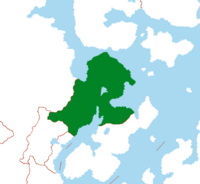Kotowari: Difference between revisions
No edit summary |
No edit summary |
||
| Line 30: | Line 30: | ||
|capital = Kotowari City <!--Name of country/territory's capital, wikilinked if link exists--> | |capital = Kotowari City <!--Name of country/territory's capital, wikilinked if link exists--> | ||
|coordinates = <!-- Coordinates for capital, using {{tl|coord}} --> | |coordinates = <!-- Coordinates for capital, using {{tl|coord}} --> | ||
|largest_city = | |largest_city = capital | ||
|largest_settlement_type = <!--Type of settlement if largest settlement not a city--> | |largest_settlement_type = <!--Type of settlement if largest settlement not a city--> | ||
|largest_settlement = <!--Name of largest settlement--> | |largest_settlement = <!--Name of largest settlement--> | ||
| Line 36: | Line 36: | ||
|national_languages = {{plainlist| | |national_languages = {{plainlist| | ||
* {{wp|Tamil language|Ramil}} | * {{wp|Tamil language|Ramil}} | ||
* {{wp|Shakyan language| | * {{wp|Shakyan language|Nakhaine}} | ||
}} | }} | ||
|regional_languages = {{plainlist| | |regional_languages = {{plainlist| | ||
* [[Shakya| | * [[Shakya|Arakhaine]] | ||
* [[Shakya|Kurdokhaine]] | |||
* [[Shakya|Sokhaine]] | |||
* [[Tulu language|Meyua]] | |||
* [[Mahanan]] | * [[Mahanan]] | ||
* [[Oharic]] | * [[Oharic]] | ||
| Line 51: | Line 53: | ||
|languages2 = <!--Languages of this second further type--> | |languages2 = <!--Languages of this second further type--> | ||
|languages2_sub = <!--Is the second alternative type of languages a sub-item of the previous non-sub type? ("yes" or "no")--> | |languages2_sub = <!--Is the second alternative type of languages a sub-item of the previous non-sub type? ("yes" or "no")--> | ||
|ethnic_groups = | |ethnic_groups = Ramils, Nakhas, Arakhas, Kurdokhas, Sokhas, Mahanan, Gomukhas | ||
|ethnic_groups_year = <!--Year of ethnic groups data (if provided)--> | |ethnic_groups_year = <!--Year of ethnic groups data (if provided)--> | ||
|ethnic_groups_ref = <!--(for any ref/s to associate with ethnic groups data)--> | |ethnic_groups_ref = <!--(for any ref/s to associate with ethnic groups data)--> | ||
| Line 67: | Line 69: | ||
|religion_year = <!--Year of religion data (if provided)--> | |religion_year = <!--Year of religion data (if provided)--> | ||
|religion_ref = <!--(for any ref/s to associate with religion data)--> | |religion_ref = <!--(for any ref/s to associate with religion data)--> | ||
|demonym = | |demonym = Kotowersian or Kotos | ||
|government_type = {{wp|Unitary state|Unitary}} {{wp|Dominant-party system|Dominant-party}} {{wp|Parliamentary Republic}} <!--(often a compound multi-wikilinked term, e.g. "Federal semi-presidential constitutional republic", etc)--> | |government_type = {{wp|Unitary state|Unitary}} {{wp|Dominant-party system|Dominant-party}} {{wp|Parliamentary Republic}} <!--(often a compound multi-wikilinked term, e.g. "Federal semi-presidential constitutional republic", etc)--> | ||
|leader_title1 = President <!--(for a country, usually the head of state's (wikilinked) title, e.g. "President", "Monarch")--> | |leader_title1 = President <!--(for a country, usually the head of state's (wikilinked) title, e.g. "President", "Monarch")--> | ||
Revision as of 07:32, 21 March 2022
People's Republic of Kotowari கோட்டோவாரி மக்கள் குடியரசு Kōṭṭōvāri Makkaḷ Kuṭiyaracu (Ramil) | |
|---|---|
|
Flag | |
 Map of Kotowari | |
| Capital and | Kotowari City |
| Recognised national languages | |
| Recognised regional languages | |
| Ethnic groups | Ramils, Nakhas, Arakhas, Kurdokhas, Sokhas, Mahanan, Gomukhas |
| Religion | |
| Demonym(s) | Kotowersian or Kotos |
| Government | Unitary Dominant-party Parliamentary Republic |
• President | Krishan Thanurajan |
• Prime-Minister | Bahira Aadhithya |
| Area | |
• | 640,456.47 km2 (247,281.63 sq mi) |
| Population | |
• 2022 estimate | 52,860,000 |
• 2018 census | 52,423,203 |
This article is incomplete because it is pending further input from participants, or it is a work-in-progress by one author. Please comment on this article's talk page to share your input, comments and questions. Note: To contribute to this article, you may need to seek help from the author(s) of this page. |
Kotowari (Ramil: கோட்டோவரி or Kōṭṭōvari (Nakhaine: Kadofarikh)), officially the People's Republic of Kotowari is a country in Oriental Europa on Eurth. Bounded by the Jasmine Sea to the north, the Rosario Sea to the west and the Menelassar Bay to the south, it shares land borders with Tamurin to the south-east and Mahana to the south-west. It is also within the vicinity of San Ba across the Jasmine Sea.
Historically existing in the form of multiple kingdoms - including the powerful Southern Shakyan Principalities, Kotowari united in the late 17th century following the Kotowari War of Unification, The Kingdom of Kotowari was established officially, following the war, in 1677 under the rule of the Aparnan Dynasty. In 1943, Kotowari became the People's Republic of Kotowari after Queen Leyani II handed power to a parliamentary system from the monarchy, with the royal family being completely dissolved by 1983. Since 1913, Tamurin has been a democracy led by a President, managed by a Prime Minister, and governed by a unitary parliamentary constitutional republic based on the Westminster system. They are a major power in eastern Europa and arguably Orient's biggest power following Orioni. They are a member of a number of international organisations such as the Assembled Nations, Entente of Oriental States and Oriental Association for Regional Cooperation.
Etymology
Kotowari is of Shakeysian origin, is stems from original city of Kadofarikh Puri - one of the original eighteen principality city-states named after the title of a Pre-reformed Juruvanic anthropomorphic diety. "Kadoft-Arikht", means Amorphous Skull. The "Kadofarikh" diety was the shapeshifting frog god of chaos, change, and adaptability. Due to political instability, Kotowari was taken from Shakyan rulers by the Ramil majority and became a major cultural and trade center for the Ramils.
Geography
(WIP. Landscape. Climate.)
History
The Ramilian Coast is ancient and has some of the oldest writings as well as monuments, however Shakeysians invaded from the North and conquered most of the Ramil heartland. The sparsely populated Northern Kotowari is predominately peopled by the Southern Shakeysians, while the densely populated Southern coastline of Kotowari is ethnically Ramil. Northern Kotowari has its origins in the Shakyan Principalities that once dominated the a large region before being conquered by a resurgent Ramil kingdom.
- Look into Wari culture for similar climate.
- Consider relationship with the Pearl Road network, other Jasmine Sea countries, neighbouring Mahana / Tamurin.
- Joined the EOS in $year.
Politics
(WIP. Government. Political parties. Foreign relations. Military.)
Economy
(WIP. Eployment. Exports. Energy. Transport. Media. Currency.)
Demographics
Juruvanism is followed by most of the Shakeysians while Gaism ("and other Indic religions like Jainism") is followed by the Southerly Ramil ethnicity.
Cultures
Southern Shakeysian culture shares a lot with Sokhainean, as the Sokhaineans are a Southern Shakyan people group. (WIP. Literature. Visual arts. Music. Cuisine. Sport.)


